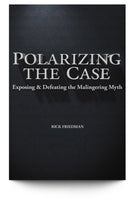Polarizing the Case from Trial Guides on Vimeo.
Polarizing the Case is the #3 book of all time at Trial Guides, just behind Rules of the Road and David Ball on Damages. It has been called "the bible for anyone trying cases in today's climate" by legendary trial lawyer Brian Panish.
With Rules of the Road™, Rick Friedman (with co-author Patrick Malone) changed the way tens of thousands of plaintiff's lawyers try their cases. In the process, he established himself as one of the nation's leading tacticians in the battle for civil justice. With Polarizing the Case, Friedman teaches us not to fear allegations or insinuations that our client is malingering or exaggerating injuries.
Polarizing the Case is split into two parts. Part one discusses the Polarizing method. This method is critical in any type of personal injury case where the defense will infer that your client is either faking or exaggerating their injuries. Instead of saying the client is lying, the defense witnesses will say the client is "malingering" (a conscious decision to fake or exaggerate symptoms) or that the client has either "somatoform disorder" or "somatization disorder" (both unconscious forms of faking and exaggerating symptoms). These allegations are almost always an intentional decision by the defense witness to mislead jurors when the injured person has well substantiated injuries. Often the defense witness will use junk science such as the Fake Bad Scale to represent to the jury that they can confirm that the client is lying.
Rick Friedman defines the problem, and offers a solution. He takes you through screening and preparing the case, writing the complaint, discovery, what to look for in the IME report, and deposing the defendant and the defense doctor. He discusses the choice between revealing the defense expert deception in deposition versus trial. From there he turns to trial preparation, motions in limine, voir dire, opening, your case in chief, cross examination of the defense doctor, and closing statement. In each phase of pre-litigation case development and within litigation and trial, Rick discusses how to fight defense lawyers and defense lawyers who claim your client is malingering, or has somatoform disorder or somatization disorder. He discusses how to clearly demonstrate to the jury that the defense will count your client's honest answers on the MMPI personality test against them, and how they will misrepresent they have scientific substantiation that your client is a liar.
In the second part of Polarizing the Case, you get "directors cut" insights of the Polarizing method in one of Rick Friedman's trials. He walks you through the trial transcript discussing how and why he made the choices he did to achieve a great outcome in a conservative jurisdiction. He provides you an introduction to the case, the husband's testimony, the plaintiff's doctor's testimony, a friend's testimony, the client's testimony, the cross examination of the defense doctor, and then closing statement.
Polarizing the Case may not be for the faint of heart, but it is very effective. Tens of thousands of lawyers have purchased Polarizing the Case, many of whom have created careers filled with stunning verdicts using this method. When done correctly, unveiling the defense doctor deception of the jury, the results can be explosive. Don't miss this important book.
- Introduction
- Part I: Description
- Defining the Problem
- A Solution
- Screening and Preparing the Case
- The Complaint
- Written Discovery
- Deposing the Defendant
- The IME Report
- Deposing the Treating Doctor
- Depsoing the IME Doctor
- Calling the Expert's Bluff
- Motions in Limine
- Tone at Trial
- Voir Dire
- Opening
- Case in Chief
- Cross Examination of the IME Doctor
- Closing
- The Psychologic of Polarizing
- A Chapter for Defense Counsel
- Polarizing in Other Types of Cases
- Part II: Illustration
- The Lace Case
- Opening Statements
- The Husband's Testimony
- The Plaintiff's Neuropsychologist's Testimony
- The Friend's Testimony
- The Client's Testimony
- The IME Doctor's Testimony
- Closing Arguments
- Appendix A
- Appendix B
What Legal Leaders Are Saying
— Larry V. RobertsBefore trial, we were offered nothing. At trial, I used Polarizing the Case for the first time. My client had $17,000 in medical bills for rotator cuff surgery. The defense attacked my client, who was an honest, hard-working family man, as a liar, cheat, and fraud who was trying to get something for nothing. After trial, before the verdict, we were offered $125,000—my client refused. The jury returned a verdict of $500,000. Polarizing the Case is a masterpiece that I recommend to every plaintiff’s attorney!
— Steven L. Shaw, editor-in-chief of the Washington State Trial Lawyers Association Trial NewsPolarizing the Case teaches lawyers to turn tables on malingering defense.
— Todd J. Bloomfield, The Advocate, February 2008If you have been dissatisfied with the amount of the verdicts you have been getting or would like some fresh ideas to improve your presentation of damages at trial, Polarizing the Case is worth your time and money.
— Dr. Arthur Croft, author of Whiplash Injuries: The Acceleration/Deceleration SyndromePolarizing is a great book for experts, even though it was written for lawyers.
— Richard KaudyI’ve used the Polarizing technique for about four years now, and have not once been denied justice in my last eight trials. I’ve had to ask juries to listen carefully to the words the defense counsel uses, who hint, wink, insinuate and suggest however softly that my client is a liar, a fraud and a malingerer because they won’t flat-out say what they mean. But their message is unmistakable. And to date, not one defense counsel has owned up to their tactics. I’ve seen jurors smile when they recognize the tactics after I point them out.
— Monrae L. English, Wild, Carter, and TiptonMy heart skipped a beat when I first heard from the defense that “perhaps my client was a malingerer.” I didn’t say a word, I didn’t argue and I took them to trial having faith in the polarizing technique. I shamelessly used it (almost word per word). The offer was $35,000 and my verdict was for $497,000. Thank you Mr. Friedman for such a wonderful technique.
— Charles R. Douthat, Esq., Jacobs and DowThe day before a jury gave me a $1.8 million verdict in a case that I put together and presented based on principles in Rick’s two books, Rules of the Road and Polarizing the Case (along with a little help from Reptile). His techniques really worked. Mine was a psychiatric overlay case. The defense was calling my client a liar/malingerer, without actually saying the words. I had to turn the defense neuro-psychatrist and show that he was the liar. Which I did, using a lay witness, as Rick recommended in his book.
— Timothy J. Cavenagh, P.C., Chicago, IllinoisThe jury in our case returned a verdict of $476,880.28, less 20% for comparative negligence, for a net of $381,504.28 in a whiplash case. The plaintiff rear ended a car, that had just rear ended the defendant’s vehicle. $16,000 medical, of which $12,000.00 was for ER. Other bills for 3 doctor’s visits and 10 physical therapy sessions. Last treatment Aug. ’05. Offer during trial $20,000. Demand $75,000. Before closings, the judge (in very conservative county) told me I ‘lost this jury,’ and predicted a verdict of between $15K and $25K. Asked the jury for $784,080.28. The defense suggested medical bills, minus whatever comparative (claimed plaintiff going too fast). Of some interest, jury gave 100% of $384,000 for pain and suffering, before reducing by 20%. Thanks for all you do to share your wisdom with the rest of us, so that we can get the best possible results for our clients. BTW, each time I had to drive out to court, I listened to your Moral Core CD in the car. Pure genius.
— Karen Koehler, author of Litigating Minor Impact Soft Tissue Cases, and listed in Best Lawyers in AmericaStunningly simple in concept, yet more effective than any other approach I’ve seen to neutralize unfair defense doctors.
— Michael J. Bidart, Esq., fellow of the International Academy of Trial Lawyers, American College of Trial Lawyers, the American Board of Trial Advocates, and listed in Best Lawyers in AmericaRick Friedman’s stunning effort, Polarizing the Case: Exposing and Defeating the Malingering Myth unmasks feelings that all trial lawyers have no doubt had at some level in every case.
— David Ball, Ph.D., author of David Ball on DamagesRemember the old Raid commercials where Mr. Raid sprays the dirty slime bugs, sending them screaming and cursing to a horrifying, shrivelling, screaming death?
— Jim Perdue, fellow of the International Society of Barristers, the American College of Trial Lawyers, the Inner Circle of Advocates, and the author of I Remember Atticus and Winning with Stories[This book] is the Sun Tzu treatise for attacking and defeating common defenses in personal injury cases.
— Michael Koskoff, member of the Inner Circle of Advocates, and listed in Best Lawyers in AmericaRick Friedman’s important new book is essential for all lawyers who have suffered the sting of hearing their clients’ real injuries mocked, minimized and maligned.
— Mike Abourezk, member of the Inner Circle of Advocates, listed in Best Lawyers in America, Steven J. Sharp recipient, and named Trial Lawyers College Mid-West Warrior of the YearI read lots of books about lawyering, and after a while a lot of it starts to sound the same. The same recycled ideas, the same rules, the same strategies. But every now and then someone comes along with something that breaks the monotony. Rick Friedman’s book Polarizing the Case is one of those.
— Brian Panish, member of the Inner Circle of Advocates, the International Society of Barristers, and lead counsel in the largest personal injury and product liability verdict in American judicial history ($4.9 Billion)[It] is the Bible for anyone trying cases in today’s climate. It covers all aspects of trying a personal injury cases today.
— Eric Fong, instructor and president of the F-Warriors, Trial Lawyers CollegeEvery lawyer who represents injured souls must read this book.














 View Excerpt
View Excerpt